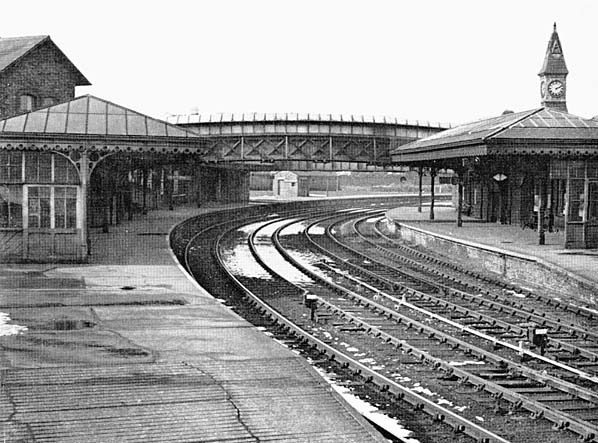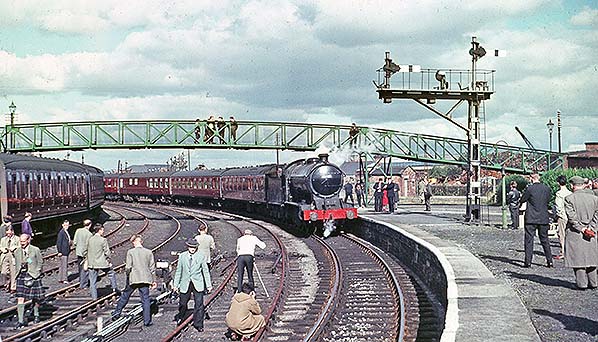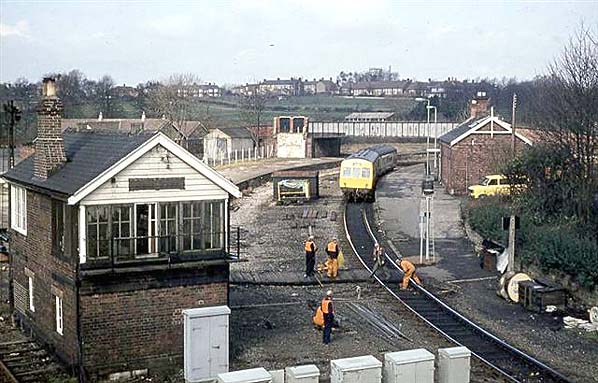|
Notes: The original terminus of the Stockton & Darlington
Railway opened at a temporary terminus at South Church on 19.4.1842.
Initially trains were steam hauled but the following day this
was changed to horse power but as horses were unable to judge
their footing in a dark tunnel at Shildon this was once again
changed to steam power. Until the opening of the Bishop Auckland
Branch to Durham and Leamside a road coach service was run from
South Church to Rainton Meadows for through travelers. On 30th
January 1843 the line was extended to a permanent Bishop Auckland
station.
The North Eastern Railway opened a temporary terminus in Tenter
Street on 1.4.1857. The Stockton & Darlington and North
Eastern stations were replaced by a joint station about December
1857. The station was rebuilt on 2.12.1867 and rebuilt in its
final triangular form in 1905. The original station was closed
on 6.6.1986 with a new short single platform being built on
the site of the Crook platform on the southern side of the triangular
station serving trains from Darlington.
BRIEF HISTORY OF THE BISHOP
AUCKLAND - DURHAM BRANCH LINE
The first railway to Bishop Auckland opened in 1843 as an extension
of The Stockton & Darlington Railway from South Church to
The Wear Valley and the town eventually developed into an important
interchange point with lines radiating to all parts of the railway
network including Darlington, Crook (until 1939 this was a through
route to Swalwell on Tyneside via Tow Law, Consett Steel Works
[Derwent Iron Co], Shotley Bridge and the Derwent Valley) &
Weardale, Spennymoor, Barnard Castle and Durham. The station
was unusual in shape being triangular, it was no problem if
a locomotive needed turning.
The line between Bishop Auckland and Durham opened to freight
19.8.1856 and to passengers on 1.4.1857 with three intermediate
stations at Hunwick, Willington and Brancepeth. A forth station
serving Brandon Colliery was added on 1861. To the North the
branch joined the ECML at Rellymill Junction South of Durham
where a line also trailed in from the left from the Lanchester
Valley and Consett. Deerness
Valley Junction sited just south of Rellymill Junction on
the Bishop Auckland line was a three way junction with the Waterhouses
branch trailing in from the west and a spur to Lanchester Valley
and Consett leaving to the North-West.
The line also served a number of collieries including Hunwick
Colliery with a line to Newfield Colliery and Brickworks from
Hunwick Station, West Hunwick Colliery, Rough Lea Colliery,
Willington and Sunnybrow Collieries via a link to The West Durham
Railway, Brancepeth Colliery (with a colliery line to Oakenshaw
Colliery), Brandon Colliery (with a colliery line to Brandon
Pit House Colliery).
The line was occasionally used by mainline express traffic
diverting to avoid engineering works between Darlington and
Durham.
The Sunderland - Durham - Bishop Auckland passenger service
ceased in May 1964 although it was re-opened for one day in
July 1964 for Miners Gala trains from Brandon, Waterhouses,
Ushaw Moor and Fencehouses and a few other stations. Freight
facilities were withdrawn from Brancepeth, Willington &
Brandon Colliery from 10.8.1964 (Hunwick lost its freight service
in 1958) although the line remained in use for freight for a
further four years.
Since closure, Rellymill Junction to Deerness Valley Junction
has been incorporated into a realigned East Coast Main Line
which has had its curve eased to increase line speed. Much of
the remainder of the line has now been converted into the 9.5
mile Brandon - Bishop Auckland Railway Path. The path begins
at Broompark Picnic Area. It passes through the villages of
Brandon, Brancepeth and Willington before reaching its end at
the Newton Cap Viaduct, near Bishop Auckland. The Durham platforms
at Bishop Auckland have gone and the site is now a Halfords
store.
Further reading: Durham's
Railways by Charlie Emett - Sutton Publishing 1999
ISBN: 0750920769
To see the other
stations on the Bishop Auckland - Durham branch line click on
the station name: Hunwick,
Willington,
Brancepeth & Brandon
Colliery |








 Home Page
Home Page 













